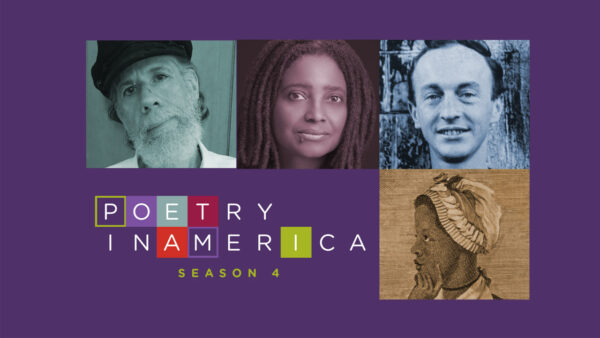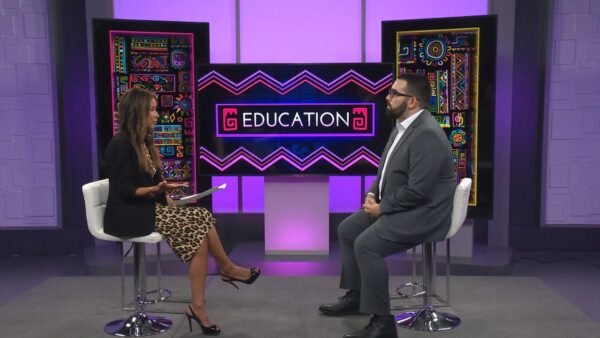The ASU Art Museum presents two concurrent solo exhibitions of work by artist Pablo Helguera. The exhibitions will be the first presentation outside the east coast of this new work by Helguera, a world renowned performance and visual artist whose work puts together historical and personal narratives in the context of socially engaged art and language. ASU Art Museum Curator Julio Cesar Morales talks about the exhibitions.
Jose Cardenas: The ASU Art Museum will present two concurrent solo exhibitions of work by artist Pablo Helguera. Both of them will open tomorrow, Pablo Elguera Libereria Donceles and Pablo Helguera Chrestomathy will be the first presentation outside the East Coast of this new works by Helguera, a world renowned performance and visual artist whose work puts together historical and personal narratives in the context of socially engaged art and language. With us tonight is Julio Cesar Morales, ASU Art Museum curator. Julio thanks for joining us, you've been on the show a number of times and these have all been great exhibitions that you've come to talk about to us. This exhibition is really big. This is a huge, big name artist, tell us about it.
Julio Cesar Morales: And Pablo is originally from Mexico City, and essentially, he went to New York to become a, you know, to seek his future as a contemporary artist but also an educator, and so, when he first arrived, he had the luck of landing a great gig at the Guggenheim. And he was in charge of the lecture series. The interesting thing that 20 years previous to that in Mexico City he was a fan of literature, a big fan of used books, and Donceles comes from a neighborhood in Mexico City, it's a street, where you find second hand books. When he, in the 80s, he found this book called Sobre El Futuro de Arte, and on the future of art that changed his life and made him want to be a contemporary artist.
Jose Cardenas: We'll show a picture that relates to how that all started. But, a bit more about him. We have the picture on now. The picture, the book on the left is the book that he found --
Julio Cesar Morales: The book on the right.
Jose Cardenas: In Spanish.
Julio Cesar Morales: And the one in the left is in New York City. Yes, and this is lectures from , so he found the Spanish version in Mexico City in the 80s, and 20 years later, when he had this new position at the Guggenheim organizing lectures, he found the original manuscript and the original book. That was in English, and he figured out that it was sort of this really interesting crossing over of cultures for him, because he, basically, replaced the person who, who created the series of lectures. In 1969.
Jose Cardenas: As we noted, he's a big name in the arts world.
Julio Cesar Morales: Yes.
Jose Cardenas: And he's exhibited all over the world in Miami, Havana, Madrid. How did you get him here?
Jose Cardenas: If you ask for the right reasons, they will come. And essentially, a lot of the work that we've been doing at the ASU Art Museum is working with renowned artist, but there is something interesting about the desert, Arizona, social climate, and sometimes, for the right reasons, they can be the choice to really show anywhere around the world. But, sometimes, these projects are really more valuable in a sense or have more of an impact in Arizona and in Phoenix.
Jose Cardenas: So let's talk about the first of the two exhibitions, Libreria is Spanish for bookstore, and we have a couple of pictures at that show, what it looks like, and is this how it was set up in New York?
Julio Cesar Morales: The first iteration was in New York, and it was impressive because they took over a gallery, and the gallery became a used Spanish language bookstore of 12,000 books. For Phoenix, we're having 14,000 books. What's interesting about New York, as well as here in Phoenix, in New York, there is 2 million Spanish speaking people and no Spanish language bookstore.
Jose Cardenas: That's so hard to, to believe. Given their population. It's hard to believe we don't have it in Phoenix but, more understandable. And, and the way that this works, as I understand it, is people go in and, and they can buy the books.
Julio Cesar Morales: They can buy the books, and they can buy one book per day.
Jose Cardenas: And it's a donation.
Julio Cesar Morales: They make a donation. Exactly. And that goes to, to a literary program. And here in the city and, and essentially, you know, you can go back to as many times as you want and, and purchase books. And what's interesting about the collection is that 90 percent are by authors Spanish speakers, authors, so, essentially, only 10 percent are translated from a different language. For example, if we go to Barnes & Noble. If we go there, you will find the majority of the books or in our public library system, is a majority of the books, are translated of popular such as Dan Brown and Danielle Steele and translated to Spanish. Here at the bookstore, that we'll have is basically 90 percent original books written by writers.
Jose Cardenas: And assess I understand it, people will go in and they express an interest in a particular area, and be directed to that category?
Julio Cesar Morales: Yes, exactly. And you know, it will also be, um, you know, again, he's a social, engaged artist in the sense that, that the work creates a second tier where he, once, wants it to serve as a platform, so usually there is programming. There is readings by authors and different performances, and book, and so on, so, we invited a lot of books, a lot of nonprofit organizations here in Phoenix, and also, ASU students to create their own programming for the bookstore.
Jose Cardenas: And that's -- there is going to be something going on every day that --
Julio Cesar Morales: Every Thursday and Friday, there is something happening.
Jose Cardenas: And this goes through what, June --
Julio Cesar Morales: It opens this Friday, March 21, and goes until June 29. And, and the hours are, are Wednesday, Thursday, Friday, and Saturday. From, from 2 to 7 p.m. And, and essentially, on Thursday and Friday, is when we have the additional programming.
Jose Cardenas: And we've already noted, part of the significance of, of the exhibition is the stature of the artists and, and also, kind of the environment in which he's coming into. Talk about that.
Julio Cesar Morales: Exactly. One of my interests and, and, as curator, at the ASU Art Museum, one of my objectives is to create more community around art projects, and a connection between community engagement with the museum, and the local communities, and also with students, as well. But, you know, our social climate where it's against the law to teach ethnic studies and K-12, you know, to me, is just really interesting.
Jose Cardenas: And periodic efforts to make the speaking of Spanish, at least an official case illegal.
Julio Cesar Morales: This is in an English-only state where, see, if you actually look, the United States has no official language recognized. And so, to me, it was very important to bring this project here to maybe attempt to create a dialogue with some of those issues that we're dealing with. And some of the programming will address some of those issues that we are in the midst of.
Jose Cardenas: Let's talk about the other exhibition, Chrestomathy. What does this mean?
Julio Cesar Morales: I will switch over to some of my notes. Basically what that means is a collection of choice literary passages used to aid in the learning of a subject. And so, essentially, the second part of the project of the exhibitions here, they mirror each other, and essentially --
Jose Cardenas: They are in two physical locations.
Julio Cesar Morales: And this one is at the Brickyard, which is a new space for the ASU Art Museum, and that is in Tempe, at 7th Avenue and Mill. And it will, we'll have the same opening on March 21.
Jose Cardenas: The first one is downtown.
Julio Cesar Morales: Yes, at 821 North 3rd street in the Roosevelt area. And that opening will be this Friday from 6:30 to 8:30. But, both locations will open at the same time, and as I said, they kind of mirror each other in other words to the work and, and the work that you will see at the Brickyard, which is what it's being called, that location will feature some video and some tech space work, and as well as some imagery and an installation from him finding the book that really influenced him on being a, a contemporary artist.
Jose Cardenas: And as I understand it, it's a series of pictures.
Julio Cesar Morales: Yes.
Jose Cardenas: From a book, and that was written in Norwegian?
Julio Cesar Morales: Yes.
Jose Cardenas: And he -- I think that the description is mistranslated.
Julio Cesar Morales: Mistranslation. So essentially, he was really intrigued by a book that he found on geology and, and he took it upon himself to, to just study the phonetics of the words and phonetically retranslating a language that he does not understand and creating a story or a subtext within that book in English, and it kind of reads as poetry in a way. And so, essentially, he appropriated this book from 1939, and recreated it as a story. And essentially, you can read it as page per page.
Jose Cardenas: And you are sharing with us his reactions to the images and the impressions it has made on him.
Julio Cesar Morales: Exactly, and the same way that this is, this is, the same way the book serves as a Spanish language bookstore but maybe, people can be a bit more open and, and consider that maybe if they don't speak Spanish, they can go into the book shop and, and look at books, that can have a different experience for them regardless of if they can speak or read Spanish.
Jose Cardenas: Both exhibitions sound exciting and thank you very much for joining us to talk about this, and hopefully you will get a good crowd.
Julio Cesar Morales: Thank you very much.
Jose Cardenas: That's our show for tonight. From all of us here at eight, Arizona PBS, and Horizonte, I'm Jose Cardenas, and have a good evening.
Julio Cesar Morales:Curator, ASU Art Museum;




















